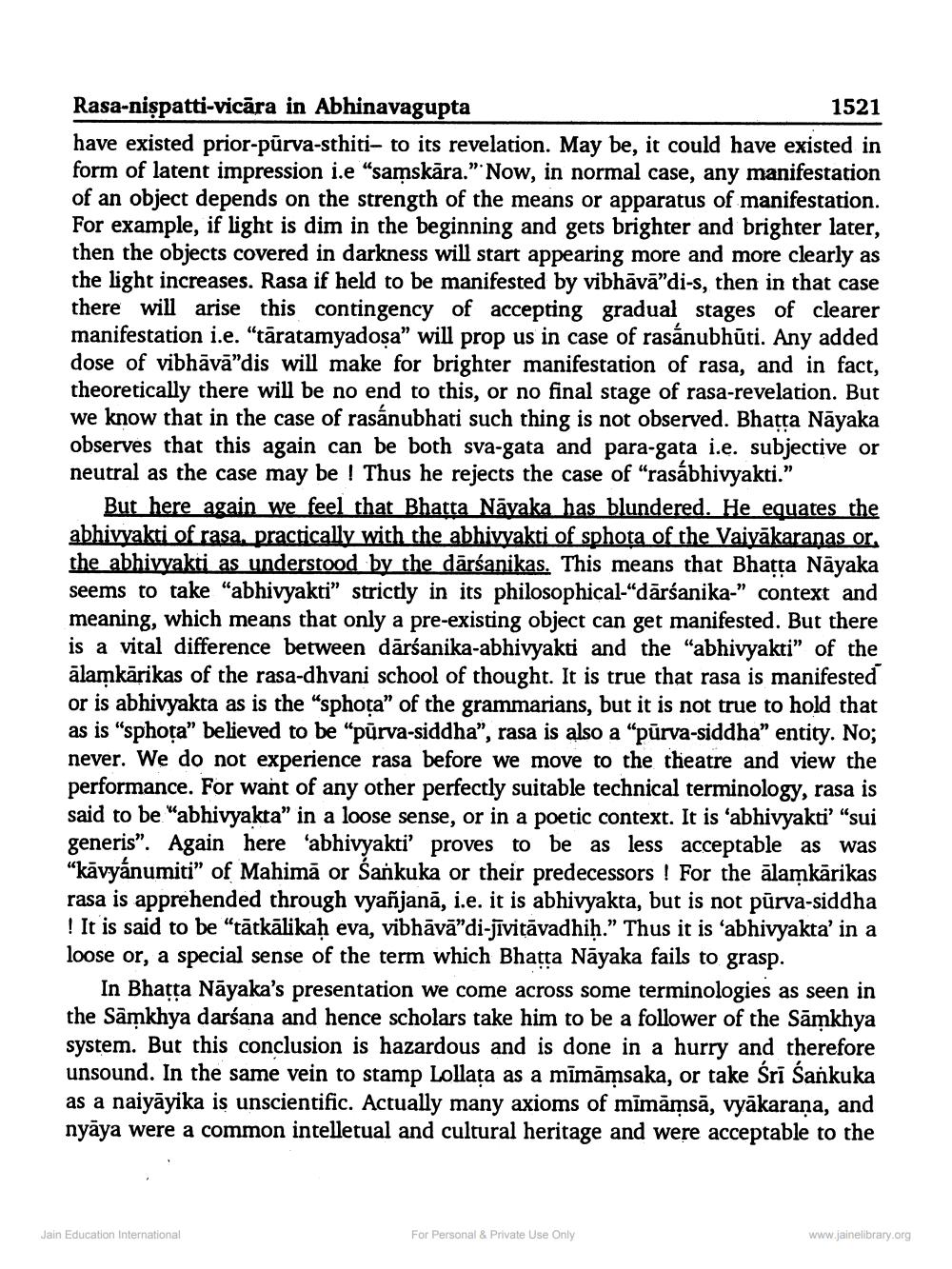________________
Rasa-nişpatti-vicāra in Abhinavagupta
1521 have existed prior-pūrva-sthiti- to its revelation. May be, it could have existed in form of latent impression i.e "samskāra."Now, in normal case, any manifestation of an object depends on the strength of the means or apparatus of manifestation. For example, if light is dim in the beginning and gets brighter and brighter later, then the objects covered in darkness will start appearing more and more clearly as the light increases. Rasa if held to be manifested by vibhāvā"di-s, then in that case there will arise this contingency of accepting gradual stages of clearer manifestation i.e. "tāratamyadosa” will prop us in case of rasanubhūti. Any added dose of vibhāvā"dis will make for brighter manifestation of rasa, and in fact, theoretically there will be no end to this, or no final stage of rasa-revelation. But we know that in the case of rasanubhati such thing is not observed. Bhatta Nayaka observes that this again can be both sva-gata and para-gata i.e. subjective or neutral as the case may be ! Thus he rejects the case of "rasábhivyakti.”
But here again we feel that Bhatta Nāvaka has blundered. He equates the abhivvakti of rasa, practically with the abhiwakti of sphota of the Vaivākaranas or, the abhivvakti as understood by the dārśanikas. This means that Bhatta Näyaka seems to take "abhivyakti” strictly in its philosophical-“dārśanika-" context and meaning, which means that only a pre-existing object can get manifested. But there is a vital difference between darśanika-abhivyakti and the "abhivyakti" of the ālamkārikas of the rasa-dhvani school of thought. It is true that rasa is manifested or is abhivyakta as is the "sphota" of the grammarians, but it is not true to hold that as is “sphoța” believed to be “pūrva-siddha", rasa is also a “pūrva-siddha" entity. No; never. We do not experience rasa before we move to the theatre and view the performance. For want of any other perfectly suitable technical terminology, rasa is said to be "abhivyakta" in a loose sense, or in a poetic context. It is ‘abhivyakti' "sui generis”. Again here 'abhivyakti' proves to be as less acceptable as was "kāvyánumiti" of Mahimā or Sankuka or their predecessors ! For the alamkarikas rasa is apprehended through vyañjanā, i.e. it is abhivyakta, but is not pūrva-siddha ! It is said to be "tātkālikaḥ eva, vibhāvā”di-jīvitāvadhih.” Thus it is ‘abhivyakta' in a loose or, a special sense of the term which Bhatta Nāyaka fails to grasp.
In Bhatta Nāyaka's presentation we come across some terminologies as seen in the Samkhya darśana and hence scholars take him to be a follower of the Samkhya system. But this conclusion is hazardous and is done in a hurry and therefore unsound. In the same vein to stamp Lollața as a mīmāmsaka, or take Śrī Sankuka as a naiyāyika is unscientific. Actually many axioms of mīmāmsā, vyākarana, and nyāya were a common intelletual and cultural heritage and were acceptable to the
Jain Education International
For Personal & Private Use Only
www.jainelibrary.org




